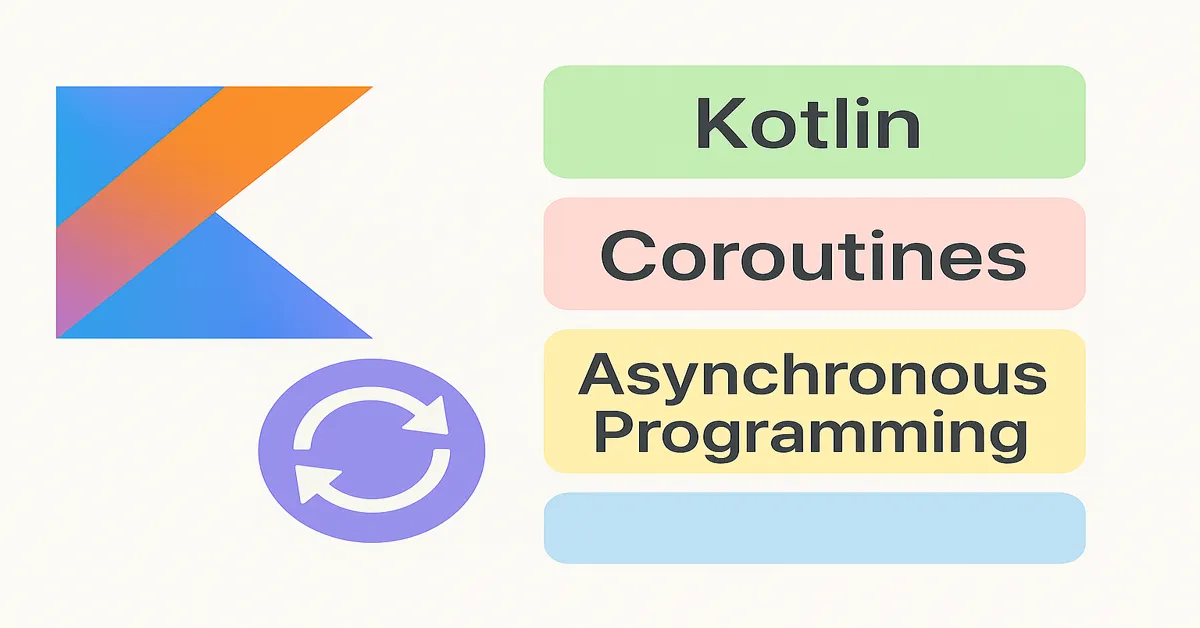As software systems grow more complex and responsive, the ability to manage asynchronous operations with clarity and control becomes essential. The traditional callback-based model for asynchronous programming, while effective, is often cumbersome and error-prone. Kotlin, designed for modern development, offers a powerful and elegant solution: coroutines.
Coroutines revolutionize the way developers handle concurrency by providing a lightweight, structured, and readable approach to asynchronous tasks. In this article, we explore Kotlin Coroutines in depth, from fundamental concepts to advanced use cases, helping you understand not just how they work, but why they matter in 2025.
Why Asynchronous Programming Needs Reinvention
Classic asynchronous programming techniques—callbacks, futures, threads—introduce significant challenges:
- Callback hell: Nested callbacks are hard to follow and maintain.
- Thread blocking: Threads are expensive resources and blocking them leads to inefficient applications.
- Error propagation: Handling exceptions across asynchronous calls is difficult.
Kotlin Coroutines offer an answer to these problems, enabling developers to write asynchronous code that reads like synchronous code, but executes efficiently.
What Are Coroutines?
A coroutine is a concurrency design pattern that you can use on the JVM to simplify code that executes asynchronously. In Kotlin, coroutines are built into the language and deeply integrated into its runtime libraries.
Core Concepts:
- Suspending Function: A function that can pause execution and resume later.
- CoroutineScope: Defines the context in which coroutines run.
- Dispatcher: Determines the thread or thread pool where the coroutine executes.
- Job: Represents the lifecycle of a coroutine.
The Basics: Writing Your First Coroutine
1. Setup
Ensure your build.gradle.kts includes:
dependencies {
implementation("org.jetbrains.kotlinx:kotlinx-coroutines-core:1.7.0")
}2. Launching a Coroutine
import kotlinx.coroutines.*
fun main() = runBlocking {
launch {
delay(1000L)
println("World!")
}
println("Hello,")
}This code prints “Hello,” immediately and “World!” after a 1-second delay—all without blocking the main thread.
Suspending Functions: The Heart of Coroutines
A suspend function is the building block of coroutines. It suspends the execution of a coroutine without blocking the underlying thread.
suspend fun fetchData(): String {
delay(1000) // Simulates a network call
return "Data loaded"
}When called within a coroutine scope, this function “pauses” execution and resumes once the delay completes.
Coroutine Scopes and Job Hierarchies
Kotlin encourages structured concurrency. Every coroutine has a job, and the jobs form a tree. Cancelling a parent cancels all children.
Key Scopes:
- GlobalScope: Not tied to the app lifecycle; use cautiously.
- CoroutineScope: Custom scope for lifecycle-aware execution.
- MainScope: Often used in Android.
val scope = CoroutineScope(Dispatchers.Default)
scope.launch {
// background work here
}runBlocking vs launch vs async
runBlocking: Blocks the current thread. For bridging blocking code.launch: Fire-and-forget coroutine.async: Coroutine that returns a result viaDeferred.
val deferred = async { computeValue() }
val result = deferred.await()Dispatchers: Controlling Thread Execution
Dispatchers determine what thread or thread pool your coroutine will run on:
Dispatchers.Default: CPU-intensive tasksDispatchers.IO: Disk or network I/ODispatchers.Main: UI updates (Android or Compose)newSingleThreadContext: One coroutine per thread (use cautiously)
Example:
launch(Dispatchers.IO) {
val result = fetchData()
withContext(Dispatchers.Main) {
updateUI(result)
}
}Cancellation and Timeouts
Coroutine jobs can be cancelled. This is crucial for managing resources efficiently in modern apps.
val job = launch {
repeat(1000) { i ->
println("Working $i...")
delay(500)
}
}
delay(1300)
job.cancelAndJoin()Also, you can use timeouts:
withTimeout(3000) {
fetchData()
}Exception Handling in Coroutines
Coroutines propagate exceptions just like regular code. Use try-catch or CoroutineExceptionHandler:
val handler = CoroutineExceptionHandler { _, exception ->
println("Caught $exception")
}
CoroutineScope(Dispatchers.Default + handler).launch {
throw RuntimeException("Boom")
}Channels and Shared Flow: Communication Between Coroutines
Kotlin Channels provide a way to send and receive values between coroutines.
val channel = Channel<Int>()
launch {
for (x in 1..5) channel.send(x)
channel.close()
}
launch {
for (y in channel) println(y)
}For hot, broadcast-style streams, use SharedFlow or StateFlow.
Flow: Asynchronous Data Streams
Flow is Kotlin’s answer to reactive streams. It supports operators like map, filter, collect, and combine.
fun numbers(): Flow<Int> = flow {
for (i in 1..3) {
delay(100)
emit(i)
}
}
runBlocking {
numbers().collect { println(it) }
}Operators
map: Transform valuesfilter: Exclude based on conditionstake: Limit streamonEach: Perform side-effects
Flow vs LiveData (Android)
Flow: Kotlin-native, more flexible, lifecycle-unawareLiveData: Lifecycle-aware, but more rigid
Use Cases for Coroutines in Real-World Projects
1. Network Calls
Use suspend functions with Retrofit or Ktor to avoid callback hell.
2. File I/O
Load or write large files off the main thread using Dispatchers.IO.
3. Database Access
Room supports coroutines directly for async queries.
4. Periodic Work
Use while (isActive) and delay() for recurring jobs.
Coroutines in Android & Compose
Kotlin Coroutines power modern Android development. Combined with Jetpack libraries and Jetpack Compose, coroutines manage background work and UI updates seamlessly.
ViewModelScope
viewModelScope.launch {
val result = repository.fetchItems()
_state.value = result
}LaunchedEffect in Compose
@Composable
fun MyComponent() {
LaunchedEffect(Unit) {
val data = repository.load()
// Update state
}
}Best Practices and Anti-Patterns
✅ Best Practices
- Use
CoroutineScopetied to lifecycle (e.g.,viewModelScope) - Handle exceptions with
CoroutineExceptionHandler - Prefer
withContextover manual dispatcher switching - Use
StateFlowfor state management in Compose
❌ Anti-Patterns
- Avoid
GlobalScopein production code - Don’t use
runBlockingin UI - Don’t block threads with
Thread.sleep()inside coroutines - Don’t forget to cancel child coroutines when needed
Testing Coroutines
Kotlin Coroutines are easily testable. Use TestCoroutineDispatcher and runTest for unit tests.
@Test
fun testSuspendFunction() = runTest {
val result = fetchData()
assertEquals("Data loaded", result)
}You can also test Flow emissions:
@Test
fun testFlow() = runTest {
val flow = numbers()
val items = flow.toList()
assertEquals(listOf(1, 2, 3), items)
}The Future of Coroutines in 2025
In 2025, coroutines are not just a feature—they are the default model for asynchronous programming in Kotlin. Tooling support is mature. Libraries from Jetpack, Spring, and Ktor all offer coroutine-based APIs.
What’s Next?
- Deeper IDE integration (IntelliJ & Android Studio)
- Advanced coroutine builders (e.g., supervisorScope, flowOn)
- Enhanced debugging and profiling support
Final Thoughts: The Productivity Power of Coroutines
Kotlin Coroutines are a transformative feature for modern development. They replace brittle, callback-based logic with expressive, readable, and reliable code. With features like structured concurrency, suspending functions, flows, and built-in exception handling, coroutines provide a developer experience that is both powerful and intuitive.
In 2025, any developer working on backend systems, Android apps, or reactive interfaces will benefit from mastering Kotlin Coroutines. They don’t just make asynchronous programming easier—they make it right. Clean, safe, and scalable.
If you’ve yet to embrace Kotlin Coroutines fully, now is the time. Dive in. Your future self—and your users—will thank you.
Read:
Building RESTful APIs with Kotlin and Ktor: A Beginner-to-Pro Guide
Spring Boot with Kotlin: Boost Your Productivity in Web Development
Mastering Jetpack Compose with Kotlin: Build Declarative UIs in 2025
Kotlin Multiplatform Mobile (KMM): Write Once, Run on Android & iOS
FAQs
1. How do coroutines improve code readability compared to callbacks?
Coroutines allow asynchronous code to be written sequentially, avoiding nested callbacks and “callback hell,” making the code easier to read and maintain.
2. What is structured concurrency in Kotlin Coroutines?
Structured concurrency ensures that coroutines are launched within a scope, creating a hierarchy where cancelling a parent coroutine cancels all its children, preventing resource leaks.
3. How do I handle exceptions in multiple concurrent coroutines?
Use CoroutineExceptionHandler or try-catch blocks within coroutines. Supervisors like supervisorScope can isolate failures so one coroutine’s error doesn’t cancel siblings.
4. Can coroutines be used for CPU-intensive tasks?
Coroutines are designed for asynchronous I/O and light concurrency. For CPU-intensive tasks, use Dispatchers.Default to offload work to a thread pool optimized for such operations.
5. Are Kotlin Coroutines compatible with other asynchronous frameworks?
Yes. Kotlin provides interop mechanisms to integrate coroutines with other async APIs such as RxJava, CompletableFuture, and callback-based systems.











